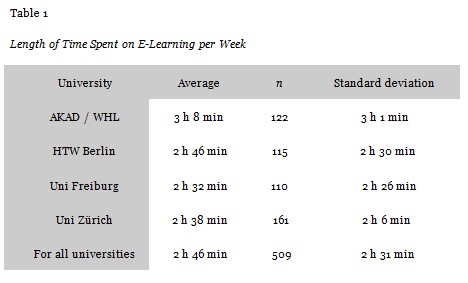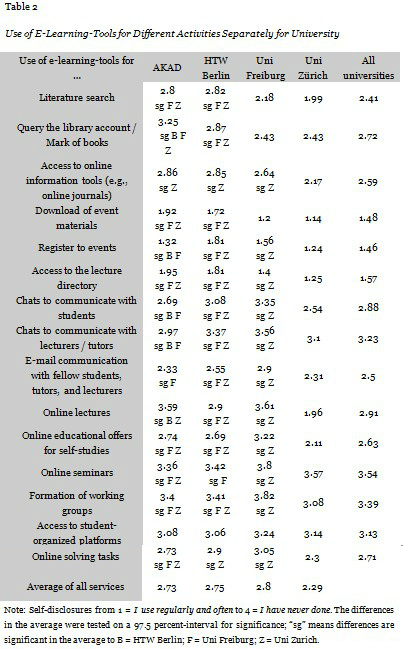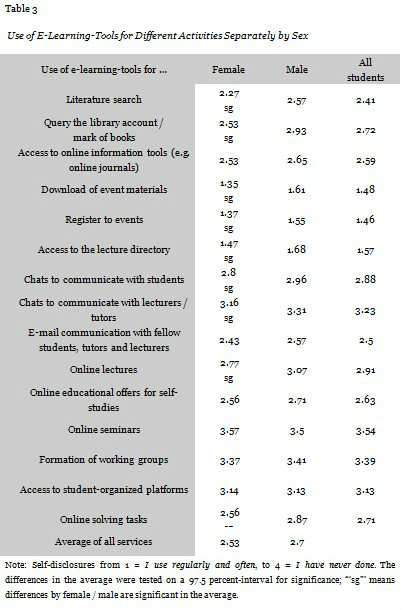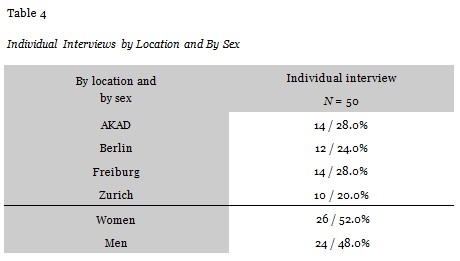

 |
 |
Bernd Remmele and Matthias Holthaus
WHL Graduate School of Business and Economics, Germany
The starting point of the paper is the co-construction of gender and technology, that is, the theory that the usage of and the attitude to certain kinds of technology are a way to “do” one’s gender. A survey is presented that supports the assumption that with the routinization of e-learning in higher education e-learning loses its character as a technology, which can be used for gender performance. With the routinization of its usage e-learning is becoming a gender-neutral tool with no outstanding technological appeal. However, though doing gender may disappear in certain fields the co-construction of gender and technology is still valid as basic structure. Furthermore, the results show that e-learning meanwhile supports the attitude we call study as consumption, that is, the expectation that the main e-learning features are usual services to be provided by the educational institution. This attitude is to be found among male and female students alike.
Keywords: Gender governance; e-learning; co-construction of technology; gender
“Gender is a practice of improvisation within a scene of constraints. Moreover, one does not ‘do’ one’s gender alone. One is always ‘doing’ with or for another, even if the other is only imaginary” (Butler 2004. p. 1). Technology is a major way of doing gender in Western countries and this is particularly true in Germany where the study described in this paper took place.1 According to Wacjman (1991, p. 37) technology, that is particulary definitions of skill, guarantees a privileged position to men, so that it is rather a question of ideology and social constructions than of actual competencies possessed by men and women. Both dimensions (i.e,. technology and gender), or rather their relation to one another, are culturally determined. As can be seen for example from the gender relation in engineering courses, this relation is rather strong in cultures like Germany and much weaker in other cultures like Eastern Europe.
Hence the co-construction of gender and technology (Faulkner, 2001; Wajcman, 2004) is dynamic as it is based on the changing relation of these dimensions (cf. Gildemeister 2004; Lie, 2003; Schinzel, 1999). The point is that “doing gender” (West & Zimmerman 1987) is an on-going process that is based on the meaningful resources to be found within a certain social context. As a result, this co-construction can develop new forms while other forms disappear although this does not indicate that the co-construction is totally capricious. When a certain technology becomes part of everyday routine and does not possess outstanding tech-savvy features, it is inapt as a resource for gender differentiation even in a culture where there is usually a strong relation.2 Such a technology has to have a more complex, more intricate appearance or image in order to demonstrate outstanding tech-savviness which, in itself, can be “loaded” with gender. Its usage must (seem to) imply specific expertise (which men like to claim they have) that is resistant to handling by novices (which women think they are). So, among other things, the gender potential of a certain technology is dependent on its routinization or general everyday usage (cf. Pasero, 1999, p. 13). Doing gender with technology thus means to use this (symbolic) field in order to perform one’s identity, of which gender is a substantial part that therefore is to be performed.
E-learning is (or better was) to be considered the kind of technology by which gender can be done, and has been done. E-learning – also on the level of higher education, the level with which we are dealing here – looked like technology and there were pertinent discussions on how to deal with that technology from a gender or feminist perspective (e.g., Brunner 1992; Blum 1998). However, many e-learning features, like other ICT usages, which were considered gender-loaded some years ago, ceased to look like technology and are now taken for granted as being everyday routine. This gender gap is closing (Imhof et al., 2007). Accordingly, as e-learning ceases to be a specific technology it becomes less suitable for gender expression. Meanwhile the discussion on gender and e-learning in general seemed to have moved to regions or cultures where the implementation is more recent and e-learning is thus not yet routinized (e.g., Ong & Lai, 2006).
As a starting point for our analysis of higher education e-learning scenarios we assumed that the ever-increasing and necessary usage of e-learning would lead to a de-gendered routinization because it would lose its potential to express gender (for others and oneself). The effects of its all-pervasive influence in higher education – a consequence of the general necessity of having to use computers and the Internet for learning – resulted in a gradual disappearance of its potential for doing gender. With regard to e-learning, the possibilities to perform one’s gender decreased where there was no potential to position oneself as being either tech-savvy or ICT averse.
So we did not look at gendering that is the reification of gender-related meaning within a certain context, but at the specific conditions for de-gendering due to routinization.
Today, the difficulty of pinning down the arguments about gender and ICT can be exemplified by the way people often claim that boys/men are better at it, grasp it faster, etc. but then tend to add: 'maybe this is only a myth?' The point is that myths of this kind do exist and have effects. (Lie, 2003, p. 11)
In order to afford manageable, methodological access to the relevant field, we focused on student self-estimation, for example with regard to intensity and competence of computer usage. These dimensions correlate with attitude to ICT as well as to gender. In particular, self-estimated ICT-competence, as control conviction, is able to express gender differences that may exist.
Due to the lack of resources for a long-term study, we had to generate a basis for comparison by carrying out analyses at four different German-speaking universities, each with differently developed e-learning scenarios. Those involved were the Albert-Ludwigs-University Freiburg, AKAD Hochschulen, Hochschule für Technik und Wirtschaft Berlin, and the University of Zurich.3 At each of the universities, we questioned business students since business courses generally show an equal proportion of male and female students and also because the discipline in itself does not convey an inherent technology bias. (Within this sample group, age and income, which strongly influence ICT usage, are thus not so important.)
So the first of four project stages began with the analysis of the four different e-learning scenarios. In this context, the word scenario is used to express the learning-related computer and internet-based features, for example, the distribution of educational resources and study-related forms of communication as well as administrative and organisational processes implemented in online environments.
During the second stage, we developed and tested different questionnaires and an interview manual. This included a questionnaire for e-learning experts at the different universities relating to the application of e-learning implied in the four scenarios, a quantitative questionnaire, mainly for student self-estimation, and an interview manual for qualitative interviews with the students in regard to their understanding of e-learning.
The questionnaire on e-learning application was addressed to those persons who were responsible for the content and administration of e-learning at the four universities or the respective faculties. The questionnaire consisted of closed and open questions for example about the general online strategy of the university, possible off-line options available to the students in relation to particular issues, and the general acceptance shown by the students with regard to the e-learning scenario. There were further questions about the range of opportunities for e-learning in the given business courses. The main objective of this questionnaire was to determine the degree to which students are forced to use the administrative and educational e-learning components.
In the case of the student questionnaire, it consisted of 37 closed and open questions in six sections. In addition to relevant socio-demographic data, the instrument dealt with computer and internet habits, general and specific computer and internet competences, e-learning practices, the inter-action between teachers and students, and how learning was organised at the student’s university. The main objective of this questionnaire was to do a survey on the significance of self-estimated ICT-competence for e-learning practice and specifically to analyse these dimensions in relation to the different universities, that is, their development level of e-learning and the degree of usage necessity, and to gender.
The interview manual started off with an open request for a narrative about the interviewee’s choice of study. From this initial question, the manual guided the course of the interview to touch on a series of specific topics: the organisation of everyday study-life, the choice of study subject(s), study motivation, experiences with e-learning both in general and with specific features, and habits dealing with internet surfing and new media. Up to this point, the interviewer had to avoid mentioning that the research project had a gender-related objective. This dimension was only disclosed in the final part of the interview when the interviewee was asked for an opinion about different ICT-usage patterns in men and women.
During the third stage of the project, the various surveys were conducted at all four universities. In addition to the questionnaire on usage necessity, the project team also evaluated the structure of the e-learning scenarios so that in the fourth and final stage, the data could be analysed and documented as well as prepared for publication.
The four universities differed horizontally, that is, concerning the variety of different e-learning features, as well as vertically, that is, concerning the depth of penetration of relevant tasks or the usage necessity of relevant features. Based on this differentiation, the four e-learning scenarios provided a basis for comparison.
The most elaborate scenario was to be found in Zurich where e-learning is a well-established and accepted component of teaching/learning in all departments. Both administrative and content-related digitalisation is far advanced often without an analogue alternative for the different tasks and features.
AKAD is built on a blended learning system with only block seminars for face-to-face teaching. Main administrative processes are organised online. However, due to the rather outdated e-learning environment and the strong focus on self-study using printed materials, content-related e-learning activities are limited.
In Berlin, a long-term e-learning strategy and relevant learning-related approaches did exist; however, a common e-learning environment, and thereby common usage necessities, were missing at the time of our study.
The e-learning scenario in Freiburg was the least developed in our comparison group. A clear overall strategy could not be identified so testing e-learning potentials was left up to individual initiative.
The further analysis was based on a sample of 530 completed student questionnaires which were distributed across the four participating universities to students from different business courses. The questionnaires were distributed in different ways to reach the students. The main way to gain questionnaires was by visiting lectures. In the introduction by the research staff the gender focus of the project was not mentioned to the students of these lectures. On these occasions the students were also invited to participate in interviews. Another way was a call for participation on the internet pages of the four universities. At the University of Zurich, there was, at the request of students, also an online questionnaire. In addition, students who volunteered for an interview were also asked to complete a questionnaire.
The questionnaires and interviews were equipped with an anonymous code, so it was possible to analyze the questionnaires of the 50 interviewed students separately. The data showed that these 50 students did not differ noticeably from the total of 530, as for example in the average time used for e-learning or in their self-estimated competence.
With regard to our initial hypothesis concerning de-gendering by routinization, we asked here, among other things, about the length of time the students spent on e-learning per week. The average value for all students was 2 hours and 46 minutes. Taken by gender, the average value for the female students was 2 h 57 min and for their male fellow students, 2 h 35 min. Differentiated by university, the average values were as follows: AKAD 3 h 8 min, Berlin 2 h 46 min, Zurich 2 h 38 min, and Freiburg 2 h and 32 min (Table 1). The fact that AKAD showed the highest average value is not surprising when one considers that AKAD offers blended learning courses. However, the differences between the other universities were minimal and after review with a t-test, the differences were not significant. Also the difference shown in the average value by sex was not significant. Even if the differences had been significant, as self-estimations of a rather abstract dimension (hours per week) the results would still not have been very conclusive.

The answers to our question, For what purposes (private and professional) do you use computers or the Internet?, proved more conclusive for our problem. The diversity of computer and internet usage was represented in 23 issues (22 given ones, plus one open response option). The items referred to relevant current tasks and applications in relation to general professional study and/or private activities, for example, from e-mail and video gaming, via downloading music and using social networks, to blogging and working on wikis. The focus here could not be on the differences pertaining to the single items because they were too specific. We were, however, interested in the sums of the ticked issues. Differentiated by gender, the results were 12.47 out of 23 on average for the male students and 10.65 for the female students. This difference was significant by a t-test at a level of 95%. So the surveyed male students considered themselves to be more active than female students, that is, they ascribed a more varied ICT usage or more experience to themselves.
The results were also conclusive regarding the usage of various e-learning services at the universities. Here we asked questions on 15 services, such as literature search, downloading seminar documentation, seminar registration, e-mail communication with fellow students, tutors, and lecturers, and also on online lectures and online lessons for home study. The students could answer from 1 (I do this regularly and often) over 2 (I do this regularly but not often) and 3 (I have done this before) to 4 (I have never done this). The resulting averages4 provided the following results: Differentiated by universities, the differences between the smallest and largest means of the items were greater than the differences by gender.
This result could be confirmed for single items, for example, concerning literature search which showed results from the different universities as ranging from 1.99 (Zurich) to 2.82 (Berlin) (Table 2). With regard to sex, the range only extended between 2.27 (female) to 2.57 (male) (Table 3). For downloading seminar documentation the range was spread between 1.14 (Zurich) and 1.92 (AKAD). Differentiated by sex, the range was 1.35 (female) to 1.61 (male). Similarly for online lectures, by university, the span went from 1.96 (Zurich) to 3.61 (Freiburg) and by sex only from 2.77 (female) to 3.07 (male). As a last example concerning online lessons for home study the range by university extended from 2.11 (Zurich) to 3.22 (Freiburg) and by sex from 2.56 (female) to 2.71 (male). In the majority of the items used, the distribution was similar. We thus concluded that the differences found in the e-learning scenarios of the examined universities were much more characterized by the intensity of use of the available e-learning technologies than by gender. In addition, Zurich showed almost the lowest all round average values and thus the highest total usage. This goes hand in hand with the advanced digital supply structure and the lack of “off-line alternatives” available at the University of Zurich.


It was also remarkable that on average the female students assessed themselves as being more active in the usage of e-learning than their male counterparts. Based on our general hypothesis, this may be explained by the fact that e-learning in higher education is understood as learning rather than technology, thus fitting even more easily into female self-concepts.
In a further part of the questionnaire, students had to answer questions concerning their computer skills. Using Cronbach’s alpha for these questions, we developed 21 items which we divided into the three variables: competency in standard software, competency in media design, and computer skills mastery.5 The given items were for example: I have a good overview of the data on my computer; I am able to arrange documents and essays in an attractive way by using a word processor; I find it easy to solve computer problems. The students were able to respond with 1 (is not the case), 2 (is rather not the case), 3 (is rather the case), and 4 (is the case), so that conformity in the general format signified relevantly high self-confidence. The three clusters extracted from the results showed the following summary results: Concerning competency in standard software there was no significant difference between the sexes. Around 98% of male students and around 96% of their female fellow students thought that they were (rather) competent in this field. Regarding the variable competency in media design, students’ answers aggregated as follows: More than 50% of male students but only 27% of their female fellow students considered themselves (rather) competent. Finally, concerning computer skills mastery, 87% of male students assumed themselves to be (rather) competent but only 66% of female students did so.
These results can be interpreted in line with our hypothesis as follows: In everyday routinized activities (including everyday problems) computers and the Internet are merely tools with no outstanding technological appeal and are thus no longer suitable for differential gender performance. However, when the activities and applications are no longer part of everyday routine and problems appear to lack transparency and to be uncontrollable, ICT again becomes a gender biased technology suitable for expressing gender differences. Consequently, computer buffs and nerds are still typically male.
Using a little interpretational boldness, further interesting results can be found in this data. We asked questions on the diversity of computer and internet usage and the answers revealed the above-mentioned results. On that basis, we examined the diversity of computer use in regard to correlations between/with the three competence classes. For this purpose, diversity of use was split into five categories. The first category included those students who use the computer with maximum diversity, while the fifth category included the students who use the computer with minimal diversity. The second to fourth categories were the gradations in between. We also categorized the three self-rated skills into four categories. Here, the first category included students who assessed their skills as being very low while the fourth category included students who assessed their skills as being very high. The second and third categories were the gradations in between. They showed the following results: Spearman correlation, that is, the coefficient measuring the strength of the correlation, between diversity of computer use and competency in standard software, 0.345;6 Spearman correlation between diversity of computer use and competency in media design, 0.366; Spearman correlation between diversity of computer use and computer skills mastery, 0.424. Not surprisingly, there was overall a mild to medium correlation between the diversity of computer use and the self-rated computer skills since these items can be seen as being mutually related. This means, if the user assesses his competence high, he also assesses his diversity of use high.
However, viewing this from our basic assumption regarding the importance of self-assessment of competences for usage of technology, the data shows an interesting differentiation in relation to gender: Spearman correlation between diversity of use and competency in standard software is 0.417 (female) and 0.300 (male). Spearman correlation between diversity of use and competency in media design is 0.381 (female) and 0.282 (male). Spearman correlation between diversity of use and computer skills mastery is 0.443 (female) and 0.351 (male). So correlation between the self-assessed competences and the diversity of usage for female students is always slightly stronger than for the male students. Of course, this small difference could be considered as not particularly noteworthy. However, based on Hagemann-White’s (1993) assumption that the regular male behavior is dominant and a part of the co-construction of gender and technology, the slight twist in the data makes sense. Consequently, men just go ahead and use technical stuff self-confidently without bothering too much about evident competences; whereas, women tend to use applications only if they really consider themselves to be competent, or if they consider themselves to be competent through having gained the relevant experience. So, even where at the surface gender differences cease to exist the co-construction of gender and technology can still be valid as a basic structure.
As mentioned, in addition to the questionnaire we interviewed 50 students from the four universities.

The qualitative analysis of the interviews yielded a new point of view on the problem of gender and e-learning because, first of all, it revealed that students in general take a very pragmatic approach to their studies. Students have acquired the perspective of a consumer who estimates e-learning as being an everyday service based on a cost-benefit-analysis, that is, it becomes a question of time, effort, and relevance for one’s course (cf. Schirmer et al., 2011). This study-as-consumption attitude includes a set of relevant aspects: the avoidance of unnecessary time expenditure along with the expectation that the whole learning environment is designed to make pre-selected learning resources readily accessible. This implies that e-learning is regarded as a potential prerequisite for implementing and organising a study process that is as effortless (and thus as individual) as possible. The optimum process can thus be based on the learning resources that the (male or female) student receives from his university or professor and which adequately fulfil the requirements, hence saving the time involved in having to search for and find further materials.
This attitude may be reason to lament the decline of (learning) culture but it fits into our basic hypothesis since there is no difference in attitude between the sexes. The routinization (and kind of commodification) of e-learning in this higher education framework supports the proposition that it has lost its technology appeal and thus its suitability for expressing gender differences. This assumption is supported by the fact that the interviewees themselves consider e-learning as an everyday routine devoid of salient tech-savvy features as well as by the impression that computer and Internet merge into a quasi-natural information-technological unity.
However, in regard to this usual everyday technology, there are still fields in our interview data where conceptual tension can be found. One field where such tension or ambivalence shows up is the issue of possible dependency, that is, the dependency of human tasks on technology. Here, there is a tipping point between efficiency or flexibility on the one side and inevitability or habitualization on the other. The question arises as to whether it is still possible to spend at least some leisure time without the computer. A similar tension can be found in the discussion as to whether e-learning fosters or constrains communication. This problem has to be understood against the backdrop of the norm whereby face-to-face lectures or seminars are still the salient paradigm of academic learning, involving interaction between teacher, student, and fellow students at a personal level. From this perspective (of the mainly average German student) e-learning features have only a supportive or complementary function.
Almost two-thirds of the current customers of Big Fish Games, a major provider of download games, are female (Hegarty, 2012). Women are no longer reluctant to use video games, to download and install them. It has become an easy-to-do routine which provides fun. It is not a task loaded with technology anymore. Of course the usage patterns of video games can still be substantially different between the two genders. Our research however has also shown that in the case of e-learning in higher education the general usage patterns become similar. The more e-learning gains the status of an everyday learning resource, the less students (can) use it to perform their gender identity.
Overall the quantitative results of our questionnaire based survey and the qualitative results of our interview series show a common consequence: E-learning has largely lost its specific gender bias in everyday use at universities. Therefore in relation to the theory of co-construction of technology and gender where the technology appeal of e-learning is no longer valid, e-learning is rather inapt for gender construction via an identification of the individual as technophobe or technophile. Beyond that, the interview statements show a study-as-consumption attitude among students of both genders that takes e-learning as a service to be provided by the educational institution. Partially this attitude goes along with the concern that computers impair personal communication and communality.
Finally, our results imply that measures intended to compensate gender biases from a perspective of techno-governance or something similar can – in the long run – make themselves dispensable. It can be assumed that gender sensitive design of e-learning-resources (e.g., Mattern, 2009) has supported the processes of gender neutral routinization, but meanwhile it is losing relevance. Rather, the service orientation, inherent in e-learning, which fosters the study-as-consumption attitude, seems to be a critical issue if one is to conceive academic education as a means to achieve independence and emancipation of both women and men.
For the future it is thus to be expected that many more fields, also other than technology, which still show divergent gender performance will change in this respect. For instance the field of economic competences has long been a field where gender differences – similar to technology expressing less social power of women – were prevalent. Girls and women had less knowledge and more negative attitudes to economic phenomena (e.g., Hirschfeld et al., 1995). Meanwhile – with increasing social power of women – there are competence tests that do not show significant gender differences (Macha & Schuhen, 2013). Gender can be “undone”. This does not mean that gender as such should be undone. As an essential part of our identity this would not be possible anyway. However undoing gender can be considered a positive process where gender performance aligns with other social structures (e.g., technology or economy) in a way that one gender is disadvantaged in relation to another.
Blum, K. D. (1998). Gender differences in CMC-based distance education. Feminista, 2(5). Retrieved from http://www.feminista.com/v2n5/
Brunner, C. (1992). Gender and distance learning (Technical Report 19). New York: Center for Technology in Education. (ERIC Document Reproduction Service No. ED352953).
Butler, J. (2004). Undoing gender. New York: Routledge.
Faulkner, W. (2001) The technology question in feminism: A view from feminist technology studies. Women’s Studies International Forum, 24(1), 79-95.
Gildemeister, R., & Wetterer, A. (1992). Wie Geschlechter gemacht werden. Die soziale Konstruktion der Zweigeschlechtlichkeit und ihre Reifizierung in der Frauenforschung. In G.-A., Knapp & A. Wetterer (Ed.), Traditionen Brüche. Entwicklungen feministischer Theorie (pp. 201-254). Freiburg: Kore.
Gunn, C. (2003). Dominant or different? Gender issues in computer supported learning. Journal of Asynchronous Learning Networks, 7(1). Retrieved from http://www.sloan-c.org/publications/jaln/v7n1/v7n1_gunn.asp
Hagemann-White, C. (1993). Die Konstrukteure des Geschlechts auf frischer Tat ertappen?’ Feministische Studien, Kritik der Kategorie‚ Geschlecht, 2, 68-78.
Hegarty, S. (2012). Big Fish Games. Key Note at the European Conference on Games Based Learning, Cork
Hirschfeld, M., Moore, R., Brown, E. (1995). Exploring the gender gap on the GRE subject test in economics. The Journal of Economic Education, 26(4), 3-16.
Imhof, M., Vollmeyer, R., & Beierlein, C. (2007). Computer use and the gender gap: The issue of access, use, motivation, and performance. Computers in Human Behavior, 23, 2823-2837.
Lie, M. (2003). Gender and ICT - new connections. In M. Lie (Ed.), He, she and IT revisited: New perspectives on gender in the information society (pp. 9-33). Oslo: Gyldendal.
Macha, K., & Schuhen, M. (2013). ECOS – Ein unter Gendergesichtspunkten fairer Test allgemeiner ökonomischer Kompetenzen. In T. Retzmann (Ed.), Ökonomische Allgemeinbildung in der Sekundarstufe II (pp. 140-152). Schwalbach: Wochenschau.
Mattern, K. (2009). Impulse zu Gender und Diversity im e-Learning Praxisleitfaden zur Berücksichtigung von gender- und diversitygerechten Aspekten in Online-Bildungsangeboten. Vienna.
Ong, C.-S., & Lai, J.-Y. (2006). Gender differences in perceptions and relationships among dominants of e-learning acceptance. Computers in Human Behavior, 22, 816-829.
Pasero, U. (1999). Wahrnehmung – ein Forschungsprogramm für die Gender Studies. In U. Pasero & F. Braun, F. (Eds.), Wahrnehmung und Herstellung von Geschlecht - Perceiving and performing gender (pp. 13–20). Opladen: Westdt. Verl..
Schinzel, B. (1999). Informatik, vergeschlechtlicht durch Kultur und Strukturen, ihrerseits vergeschlechtlichend durch die Gestaltung ihrer Artefakte. In D. Janshen, Frauen über Wissenschaft (pp. 61-81). Weinheim: Juventa.
Schirmer, D., Brüstle, P., Haubner, D., Holthaus, M., & Remmele, B. (2011). Studieren als Konsum. Veralltäglichung und Degendering von E-Learning. Boizenburg.
Wajcman, J. (2004). TechnoFeminism. Cambridge: Polity Press.
West, C., & Zimmerman, D. (1987). Doing gender. Gender and Society, 1(2), 125-151.
1 The paper presents results of the project Das aufwändige Geschlecht (The arduous sex/gender) which was funded by the DFG (German Research Foundation) from 2007 to 2010.
2 A study of Gunn (2003, p. 19) concluded: “The Web as a source of information and electronic mail as a medium of communication make these two emerging technologies increasingly practically relevant and interesting to women. It can then be argued that women’s expressed interests in and judgments about computers are becoming more positive as a result of the technology’s increasing pragmatic significance.”
3 The project team consisted of researchers from the University of Freiburg and the Wissenschaftliche Hochschule Lahr, which is part of AKAD. Berlin and Zurich could be commited to support the project due to personal contacts. However Zurich was particularly asked to take part because of its advanced e-learning scenario.
4 From a methodologically rigorous point of view it is not allowed to calculate an average of ordinally scaled data (though when summing up a set of items, it is quite common). Nevertheless, we took averages because the values show interesting trends.
5 The competency in standard software was determined by the following items:
I have a good overview of the data on my computer.
I am able to effectively protect my computer from viruses and hackers.
I am able to create essays by using attractive and convenient word processing programmes.
I am able to make a well-prepared, computer-based presentation of attractive design.
I am able to process and visualize by using spreadsheet numerical data.
I am able to send e-mails with attached files to one or more persons using an e-mail programme.
I am able to find the information I am searching for quickly by using the internet.
I am able to further process by using image-processing programme, existing images or photos.
The competency in media design was determined by the following items:
I am able to create by using graphics programmes, clear diagrams, attractive invitations or posters.
I am able to take, cut and edit by using audio software sounds, language or music, so as to create an attractive audio track.
I am able to cut and edit by using video editing software digital videos, so as to create an attractive video track.
I am able to burn CDs and DVDs by using burning software and to create matching cover and stickers.
I am able to create web pages attractively and clearly and to publish the pages in the internet.
I am able to write smaller programmes in at least one programming language.
And the variable computer skills mastery was determined by the following items:
I find it easy to understand new working methods with the computer, and to understand new programmes.
I think I can solve problems that might arise while working with the computer.
I still believe I have a good competence level of computer usage even after experiencing a time of failure during usage.
I have a good feeling when it comes to my computer skills.
I can change settings (for example system settings) on the computer by myself and also customize, without having to consult anyone.
I find it easy to solve computer problems.
I think that I am good at explaining a computer programme to others.
6 The correlation has a negative sign because of the categorization in the diversity (the value for high diversity is 1, the value for low diversity is 2. In comparison to this, a low self-rated skill = 1, and a high self-rated skill = 4). We have omitted the sign for better understanding.